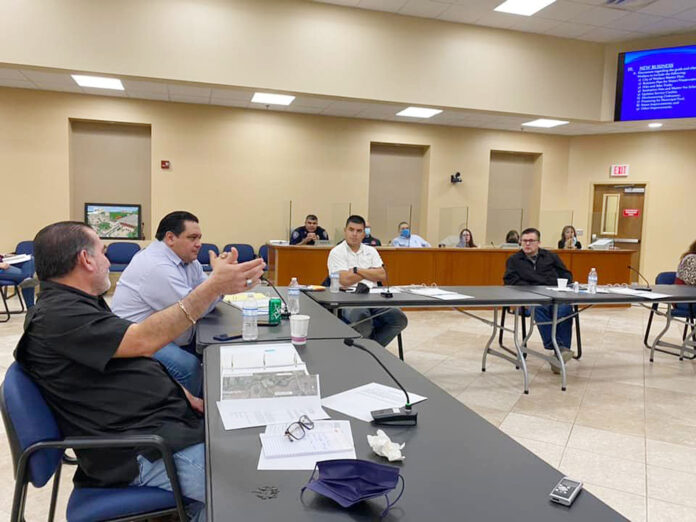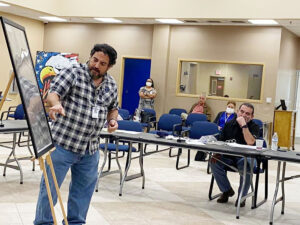
WESLACO — Elected officials and city staff gathered at city hall Saturday morning for a comprehensive goal-setting workshop.

City officials address Weslaco’s infrastructure needs during a meeting between leaders at City Hall on Saturday morning.
The group went over everything from the city’s master plan, to recreational infrastructure, utility services management and more during the four-hour long workshop.
Things kicked off with a discussion about updating the Weslaco Master Plan — a sort of guidepost for how city leaders want to see Weslaco grow in the coming years.
The master plan hasn’t been updated since 2016. As such, Weslaco engaged the services of Ian Caine, an urban planner with the Center for Urban and Regional Planning Research out of UT-San Antonio to reanalyze the city.
Beginning last February, Caine started looking at the city’s existing infrastructure — from the layout of streets and parking spaces, to business plazas, to how residential areas have evolved across various parts of the city.
He also held a series of publicly accessible focus groups throughout last year, in order to gather input from residents, Caine said.
With the bulk of the information gathering complete, Caine was on hand via videoconference to present his preliminary recommendations Saturday.
Caine began by talking about downtown revitalization, presenting a vision of a future Texas Boulevard dotted with outdoor café and artistic spaces, transforming underutilized alleyways into quick-shift spaces for outdoor markets, and incorporating multi-use garden nooks.
“Those are the things that will support a vibrant downtown life,” Caine said.
“This is a street with tremendous potential,” he said of the 15-block stretch of Texas Boulevard that already supports a healthy Main Street America type atmosphere.
Caine described how the thoroughfare’s curbside parallel parking could be modified to transform some parking spots into small outdoor seating in front of local restaurants. The spaces would be protected from traffic by large wooden planters, according to an artistic rendering.
“They’re semi-permanent. You can move them as needs change,” Caine said of the structures.
Weslaco could also maximize the use of street corners and crosswalks by developing the pedestrian spaces at intersections into “parklets” — small greenspaces that would offer shade and seating for pedestrians traversing the boulevard on foot.
The live plants would serve a dual purpose — not only beautifying the business lane, but helping manage water runoff.
Finally, Caine said the city could think about investing in installing minimal infrastructure, such as lighting, in the alleyways that crisscross behind downtown storefronts.
“Put the alleys to work as outdoor markets or art galleries,” he said.
In regard to housing, Caine touched on the housing boom that Weslaco has been experiencing recently, including the addition of numerous single-family subdivisions, as well as high-rise apartment complexes.
But what the city doesn’t have is “the missing middle,” Caine said.
Single-family subdivisions create a housing density of 1-5 homes per acre. And multifamily units, such as the newly constructed three-story apartment complexes along Westgate Drive, create a housing density of about 20 homes per acre.
But the city has few of what Caine referred to as “middle density” units — neighborhoods filled with duplexes and fourplexes that create a housing density of about 5-10 homes per acre.
Such development can serve a vital function in transitioning between the two existing neighborhood types, he said.
Caine will deliver a complete draft of the proposed master plan by March 1, with a final update slated to be completed by April 15, he said.
The draft will also include recommendations for growing Weslaco’s parks systems to include neighborhood parks and green spaces. Increasing those amenities is something that the city’s parks and recreation director, Omar Rodriguez, has already been working on for some time.
Rodriguez delivered a presentation that showed how city planners are looking to create a connected hike and bike trail system that not only traverses Weslaco in all four cardinal directions, but also links up with existing trail systems that lead as far as Mission and Port Isabel.
“As far as policy or commitment, you all have adopted the Hike and Bike Master Plan… you all have budgeted matching money,” Rodriguez reminded the commissioners.
Weslaco has set aside some $250,000 to use as matching funds for any grants it may be able to acquire to fund the development of new trails. Currently, Rodriguez is pursuing a grant from the Texas Parks and Wildlife Department, he said.
Finally, city leaders began a preliminary exploration of having city staff take over water and wastewater operations.
Currently, Weslaco’s water treatment facilities are managed and operated by a firm known as Inframark.
The firm staffs the water plants, and controls everything from water filtration to distribution. But rising operational costs and negative monetary returns have officials wondering if the city could turn things around by taking over operations themselves.
Inframark began managing Weslaco’s water services in 2015, thanks to the approval of a five-year service contract. The following year, the commission approved a two-year extension of the contract, which is set to expire at the end of this year.
However, by 2017 — just two years into the original contract term — Inframark was already communicating to city officials about expenditure overages that vastly exceeded what Weslaco had budgeted to pay.
“(T)he maintenance limit was exceeded by $65,957.54,” said Inframark Regional Manager Oswaldo Garza in an October 2017 letter addressed to then-City Manager Mike Perez.
Garza also requested tens of thousands of additional dollars in the letter for filtration chemicals and waste removal.
Costs have only continued to rise.
But if the city wants to take over water and wastewater operations, it will have to invest in personnel who have the state certifications necessary to operate the public utility, as well as other expenses.
Currently, the city is on track to realize a $2.4 million deficit in the water and wastewater fund by 2023, according to Weslaco Finance Director Vidal Roman.
Roman illustrated how that deficit could be reduced and even eliminated if Weslaco begins controlling its water in-house.
It wouldn’t be the first time Weslaco took over the management of an essential service. Earlier this year, the city commission approved a plan to take over trash pickup, ending the city’s relationship with Republic Services.
The transition between contracted solid waste pickup and in-house pickup remains ongoing. But Weslaco continues to wrangle with several hiccups, including commercial customers who are using residential waste receptacles, overflowing industrial bins that require multiple collections, and instances of vandalism that have destroyed some household trash bins.
David Arce, the city’s deputy public works director, went over the myriad issues and suggested that the best way to begin addressing problems would be for the commission to codify a sanitation fee and master fee schedule.
The commission is slated to mull the issue as the transition continues away from Republic Services.




